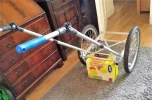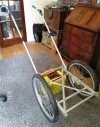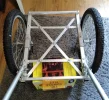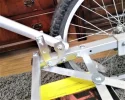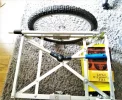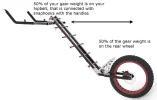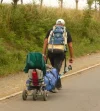Hi - trailers are great! Or rather, two-wheel trailers are great! There are no sections of the Camino that are too narrow or too rough for a trailer - for instance, the Wheelie is only 56 cms wide. Wherever your shoulders can go your trailer can go. Also the Wheelie has built in shoulder straps so that it can be quickly back-mounted if necessary, and such straps can be added to any trailer simply by buying an old cheap rucksack and using the harness from that.
But, Hound, you say that you are morbidly obese? You may do better - as mentioned above - to use a daily luggage carrier and walk as light as you can.
Also - a trailer can be like a new bookshelf - the temptation to just fill it can be almost irresistible!
I have made a trailer for Jenny in Sydney and am making my own now. I bolted a handle onto her one so if necessary she can wear her backpack and lift the light trailer by the handle, should she come across a problem such as a staircase in a refugio.
I did have a Wheelie but thought it over-engineered for Camino. The design, especially the big pack built into it, is for trekking rather than ambling and wanting to get at the sorts of pockets you get on a backpack.
Whatever anyone does, do not get a mono wheel trailer as half the weight is still on the body and they are narrower, true, but unstable. The advantage of a two wheel trailer is that the load can be organised over the axle so that there is no weight on the body. However, to stop the trailer draw bars rocking up and down one loads the trailer to give half a kilo or so of weight onto the hip belt.
The Wheelie is a seriously expensive piece of kit but there is a French one (has a wine bottle holder - no it doesn't

) that is less than half the price - they have recently renamed it Camino specific, it was the Chariot but is now the Ultreia!
- see here -
https://www.chariotderandonnee.com/chariot-de-randonneur.html?___store=chariot_en
The American army, on test, found that using a trailer uses 80% less energy expenditure than the same weight back carried and I have found this to be true. The three women, mentioned above, may have been carrying a huge amount of stuff and were also terribly unfit, as there was no other reason to give up on their trailers.
I not only carry my personal items but a large first aid kit plus back-up first aid supplies but have strolled up the steep hill out of Pamplona, and slowly descended the other side (the one with the big boulders) with no problem whatsoever, the same with the big steep hill out of Castrojeriz. But! you cannot beat the laws of physics and the difference between weight and mass. On the flat and gentle undulation you are hardly aware that there is a trailer behind you, but rising in elevation you still have to 'lift' whatever weight you have - but it is much much less effort than doing the same wearing a backpack.
And you can see the difference - especially on hills! - you constantly coolly stroll past sweaty struggling pilgrims with strained faces - this is a fact.
However, a trailer isn't necessary on Camino, not at all - if one packs
superlight then why add six kilos of trailer? and then there are the situations with refugios - they never want them in the bunk rooms, so you lock them downstairs and lift your pack up to the room. I do not fly but I understand that there can be problems sorting a trailer for loading in the baggage hold, but I don't know about that, and most trailers quickly dismantle and go into a bag.
You will read negatives about trailers but they tend to be from people who have never tried one. The first couple of minutes walking and the new owner always goes "Wow!!!! - this is SO easy!!!"
The only real 'downside' - not really

- is that you are always being stopped and asked about the trailer and pilgrims always want to try it!
End of post! - but I am just finishing making a new one and there are pics below if you are interested.
I bought a secondhand aluminium frame one-seat child carrying cycle trailer cheap secondhand on ebay and cut it down. I then made a new frame from the parts, added flat strips of aluminium to make a load platform and brackets to take the draw bars. Here is the secret of the trailer making world!! Window washing supply companies have the most wonderful strong light telescopic poles and angle brackets, and they are cheap!!
Where you see the draw bar bolted to the frame - the lower one stays bolted so that it can be pivoted back to lay flat on the frame and I sleeved the tubing there with mild steel tube to strengthen it. Has quick release 20 inch! wheels, and all dismantles in two minutes to make a rectangle that goes into a bag with a shoulder strap. Not quite finished yet - but nearly done -
any questions about building one please do message me.
View attachment 52087
View attachment 52088View attachment 52089View attachment 52090View attachment 52091














